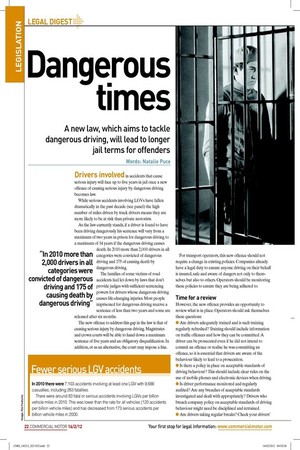Dangerous times
Page 19

Page 20

If you've noticed an error in this article please click here to report it so we can fix it.
A new law, which aims to tackle dangerous driving, will lead to longer jail terms for offenders
Words: Natalie Puce
Drivers involved in accidents that cause serious injury will face up to ive years in jail once a new offence of causing serious injury by dangerous driving becomes law.
While serious accidents involving LGVs have fallen dramatically in the past decade (see panel) the high number of miles driven by truck drivers means they are more likely to be at risk than private motorists.
As the law currently stands, if a driver is found to have been driving dangerously his sentence will vary from a maximum of two years in prison for dangerous driving to a maximum of 14 years if the dangerous driving causes death. In 2010 more than 2,000 drivers in all categories were convicted of dangerous driving and 175 of causing death by dangerous driving.
The families of some victims of road accidents feel let down by laws that don’t provide judges with suficient sentencing powers for drivers whose dangerous driving causes life-changing injuries. Most people imprisoned for dangerous driving receive a sentence of less than two years and some are released after six months.
The new offence to address this gap in the law is that of causing serious injury by dangerous driving. Magistrates and crown courts will be able to hand down a maximum sentence of ive years and an obligatory disqualiication. In addition, or as an alternative, the court may impose a ine. For transport operators, this new offence should not require a change in existing policies. Companies already have a legal duty to ensure anyone driving on their behalf is insured, safe and aware of dangers not only to themselves but also to others. Operators should be monitoring these policies to ensure they are being adhered to.
Time for a review
However, the new offence provides an opportunity to review what is in place. Operators should ask themselves these questions: • Are drivers adequately trained and is such training regularly refreshed? Training should include information on trafic offences and how they can be committed. A driver can be prosecuted even if he did not intend to commit an offence or realise he was committing an offence, so it is essential that drivers are aware of the behaviour likely to lead to a prosecution.
• Is there a policy in place on acceptable standards of driving behaviour? This should include clear rules on the use of mobile phones and electronic devices when driving.
• Is driver performance monitored and regularly audited? Are any breaches of acceptable standards investigated and dealt with appropriately? Drivers who breach company policy on acceptable standards of driving behaviour might need be disciplined and retrained.
• Are drivers taking regular breaks? Check your drivers’ tachographs to ensure that this is happening.
● Are regular checks of the condition of vehicles carried out and is identiied maintenance work carried out immediately?
● Are drivers provided with a copy of The Highway Code and other relevant codes of practice or guides?
● Does the company check the licences of new drivers or agency workers? Regular checks should be carried out of employees’ licences to ensure they remain current and in force. ● Does the company check that drivers remain it and healthy to drive?
Ensure that any gaps in risk management are identiied. If a driver is involved in an accident, he is likely to be at the centre of the subsequent investigation. However, accidents are rarely the result of one factor alone but a combination of factors. If a driver has not been adequately trained or if work pressures mean that a driver is not taking adequate rest breaks, then the company may face scrutiny.
Developments in the law, including the Corporate Manslaughter and Corporate Homicide Act 2007, make it likely that wider investigations into a company’s policies and procedures will be carried out when a fatal road trafic collision occurs. ■
● Natalie Puce is a Solicitor in the Safety Health and Environment Team at national law irm Berrymans Lace Mawer LLP Natalie.puce@blm-law.com
WHAT IS DANGEROUS DRIVING?
The offence of dangerous driving is well established. A person is driving dangerously if their standard of driving falls far below what would be expected of a competent and careful driver and if it would be obvious to a competent and careful driver that such driving is dangerous. The courts include the following as examples of dangerous driving: ● Racing or competitive driving; ● Excessive speed; ● Aggressive driving; ● Disregarding traffic signals or other road signs; ● Driving without sufficient rest or sleep. The new offence of causing serious injury by dangerous driving appears in the Legal Aid, Sentencing and Punishment of Offenders Bill 2010-12, which is going through parliament. It should become law later this year.
More information: http://assets.dft.gov.uk/statistics/ releases/road-freight-statistics-2010/road-freighteconomic-environmental-safety-statistics.pdf
Fewer serious LGV accidents
In 2010 there were 7,103 accidents involving at least one LGV with 9,686 casualties, including 263 fatalities.
There were around 83 fatal or serious accidents involving LGVs per billion vehicle miles in 2010. This was lower than the rate for all vehicles (120 accidents per billion vehicle miles) and has decreased from 173 serious accidents per billion vehicle miles in 2000.














































